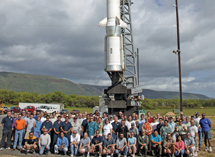
Sandia and Kansas State University researchers have teamed up to create a new flight computer for use in rockets and reentry vehicles.
A flight computer is the brains of a rocket or RV. It tells the vehicle where it is, where it’s going, and how to get there.
The new IMPACCT (Integrated Multi-Module PowerPC-based Aerospace COTS Computer Technology) flight computer replaces SANDAC (Sandia Airborne Computer), which has been used for the past 20 years and on more than 100 missions.
The new flight computer recently flew on the Missile Defense Agency’s Critical Measurements and Countermeasures Program flight test. The test was part of MDA’s test program that provides participants with the ability to reduce technical risk by testing against challenging and complex target scenes in a controlled environment.
“The IMPACCT-1 flight computer successfully flew on the MDA test which was executed to gather experimental data,” says Earl Creel, manager of Navigation, Guidance, and Control Dept. 5416. “The idea of the IMPACCT was to create a smaller and more robust flight computer around commercial processor card assemblies.”
An agreement between Sandia and the Electrical and Computer Engineering Department at Kansas State University (EECE/KSU) was formed three years ago to provide two master’s-level graduate students to work on technology developments supporting the IMPACCT computer family.
Kyle McDowell and Jerad Simon were hired by Sandia as summer interns and worked on creating the new flight computer. Both based their theses on the technology, earned their master’s degrees, and are now technical members of Dept. 5416.
Sandia’s Flight Computers Dept. 5339 was instrumental in taking the thesis prototype IMPACCT-2 to production status.
Durable, reliable, economical
Don Tolsch, manager of Dept. 5339, says the successful development and qualification efforts associated with the IMPACCT-2 flight computer have been the result of strong cooperation between Centers 5300 and 5400.
“The IMPACCT-2 computer is but one in a family of machines that will allow Sandia to address the future needs of our customers in both a time and cost-effective manner,” he says.
“As the brains of the vehicle, the flight computer must be durable, reliable, and economical,” says Kyle.
“We are fortunate that the thesis prototype worked and now we are able to expand on what we achieved.”
The primary design concept for IMPACCT was to take advantage of the continuous advances being made in commercial off-the-shelf (COTS) systems, says Jerad.
“We are not reinventing the wheel,” he says. “But we are making advances to systems by combining technology and updating the software and hardware.”
One challenge, Jerad says, is working on unforeseen problems that might arise in off-the-shelf systems.
A portion of the collaboration is to work toward the integration of PowerPC-based hardened processors, capable of running Green-Hills Integrity software (a real-time embedded OS), into upper-level electrical and computer engineering classes.
Faculty and graduate students are able to use the equipment in a classroom setting in synergy with ongoing efforts at Sandia.
The students will be able to gain extensive knowledge of the equipment in two graduate-level courses and will be able provide feedback on how to best employ the equipment and provide recommendations for improvements.
EECE/KSU assistant professor Dwight Day is principal investigator; professor John Devore is co-investigator.
Earl says the KSU collaboration has proven to be successful.